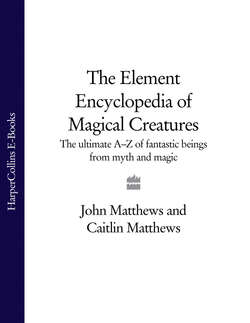Читать книгу The Element Encyclopedia of Magical Creatures: The Ultimate A–Z of Fantastic Beings from Myth and Magic - John Matthews - Страница 11
The Language of the Animals
ОглавлениеOne of the most impossible and exciting features of this book is the way in which magical creatures do not hold their form. Animals have a way of becoming humans, and humans animals. There is a good reason for this, and it is given in an Inuit poem, collected by the explorer, Knud Rasmussen:
‘In the very earliest time,
When both people and animals lived on earth,
A person could become an animal if he wanted to,
And an animal could become a human being…
All spoke the same language.’
The point at which human beings lost the ability to talk with animals is not known, but it remains a continuous thread in world folklore and myth. In the East, it was held that people ‘eat the heart and liver of serpents, hoping thereby to acquire a knowledge of the language of the animals’. Some of the Turkic tribes of Asia had the custom of giving the tongues of different animals to children who were learning to talk in order to accelerate the process.
In the West, the myth tells us that on Midsummer’s Eve, the serpents gathered together to spin a crown of ferns for their king. At their gathering they put their heads together and hissed glass wishing rings called snakestones, which would, if found, help people prosper in all enterprises. Pliny tells a similar story about ‘the druid’s egg’, a stone which is engendered by knots of serpents and which has special powers. Fern seed was the ingredient that helped herdsmen and hunters not only become invisible but also learn what animals were saying. The ability to relearn the speech common to animals and humans was also required by shamans and magicians in order to bridge the worlds between the mundane and time-bound realms and the timeless Otherworld.
There are many characters in world myth that acquire the ability to speak and understand animal speech patterns. In the Welsh story of the Oldest Animals, it is a man called Gwrhyr Gwalstwad Ieithoedd (Long Man, Interpreter of Tongues) who alone can converse with animals. He helps leads King Arthur’s nephew Culhwch to find the lost hero, Mabon, by following a string of animals who lead to his hiding place through time and memory.
The Brothers Grimm tell a Swiss story of an old man whose only son studies with a master who teaches him how understand what dogs bark, birds sing and frogs croak. His father is incensed at what he sees as a waste of education and orders his son to be killed. The servants merely kill a deer, cutting out its eyes and tongue to give their master a token of the ordered death. Meanwhile the lad continues on his way. He goes among wild dogs that are ravaging the land; learning that they are bewitched into guarding a great treasure, he finds the way to discover it and so stop them barking. Later on he hears frogs discussing the death of the pope and how the cardinals are now looking for a divine miracle in order to appoint a successor. As the hero enters the church where the cardinals sit in deliberation, two doves land on his shoulders and the clergy recognize him as pope. Ignorant of how to say his own papal investiture mass, the hero listens to what the doves coo to him and he echoes their words.
In the ‘Narnia’ books of C.S. Lewis, Prince Caspian lives in a time when people have forgotten that animals once could talk, but he learns how to seek them out and with their help restore his lost kingdom. We are in a similar time. This commonality of language is lost to many of us and we have become estranged from our creaturely kindred. We have become tame and forgotten our animal origins. When magical creatures reveal themselves to us, we are not even sure whether they are permissible, orderly, authorized.
